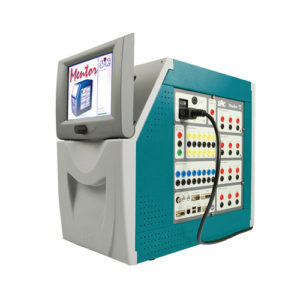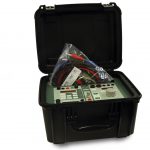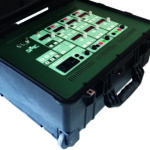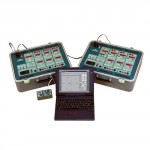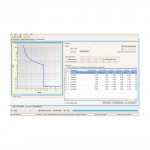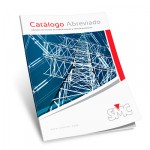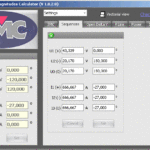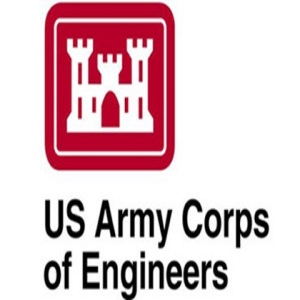Protective relays equipment
The proper operation of the protective relays is critical in the reliability and safety of power systems, protecting other devices from damage and helping to the system security. Accordingly, the testing of relays is required during the installation and commissioning process, and as part of the maintenance programs throughout its service life.
Protective relays: portable equipment for testing all types of protection schemes
Relays testing may range from a simple check of some points of the relay characteristic to a complete verification of the protection scheme logic, even including the response to transient waveforms, harmonics, etc.
Since the manufacturing of secondary injection equipment for testing protective relays has been a main activity of SMC, we are able to offer different comprehensive solutions with all the required characteristics and functions needed to ensure the proper operation of relays, in a manual or automatic testing mode; solutions which are designed for maximum efficiency, flexibility and simplicity, with the required accuracy and performance to test any kind and type of relays in all situations.
Description
Related Products
Additional Information about secondary injection test solutions
The widest range of secondary injection sets adapted to the user and the applications.
The ease of use and the testing speed are always considered in the SMC equipment, for adapting the relays testing to the user and the application. The test equipment should also deal with some practical questions required in the different situations that the user may face for the proper testing of protective relays, which might sometimes require an easy and simple human interface with quick and full manual control and other times, when required, testing the relays in automatic way.
Our experience obtained during the past 30 years has enabled us to have a complete range of equipment with different philosophies for the various applications and customers, from the simplest and autonomous sets to fully automated, for quickly performing any type of relay testing.
-
- PTE-100-C Series: a leader and world reference for protection relay testing, based in variac output regulation. The smallest and lightest single-phase secondary injection test set in the market. With IP-65 rated case, outstanding 1000 VA output power (for wide application range of protective relay tests, including the higher power demanding electromechanical relays); the PTE-100-C integrates many measurement and testing functions, and comes with a large set of upgrading options and accessories, for accurate and unbeatable fast testing at competitive price. A must-have instrument for the wide diversity of secondary injection test works in any plant or substation.
- PTE range: a wide series of digital (non-variac based) secondary injection sets for protective relays; The PTE electronic range includes single and 3-phase models, with the required high accuracy and stability for testing all kind of relays; a flexible range which includes reversibility in all output channels (current/voltage), fault dynamic testing, and interconnection capability; portable units, with high power capability, and straightforward use. Designed to serve the majority of relays testing, they can be combined with other equipment to expand the applications. These equipment are a favorite with service companies, along with the distribution and generation departments of the Utilities as they are adapted and designed to meet their requirements. The features and functionality of this range of products are not found anywhere else.
- MENTOR 12: Universal secondary injection test set for testing all kind of protective relays and protection schemes; the MENTOR 12 incorporates the latest designs and concepts for protective relay testing, based on leading edge technology. This revolutionary product, the most modern equipment of its class, fulfills the requirements of the transmission departments and the commissioning of new installations; the unique which is PC independent, with easy and intuitive touch-screen, modular concept up to 12 channels, advanced built-in test tools, independent amplifiers and lower maintenance. The MENTOR is perfectly suited for secondary injection tests, with a big sized screen that allows continuous graphic and visual monitoring of the test process, and the quickest and most complete manual control. The MENTOR integrates many useful functions for the proper testing of protective relays without the need of external PC, such as State Sequencer, Fault, Ramping, Pulse Ramps, Binary Search, COMTRADE playback, and on screen direct regulation of complex magnitudes (impedance, power, symmetrical components, homopolar voltage, etc).
The modularity of the Mentor allows multiple configurations, from the classic 3V3I (3 Voltages- 3 Currents – with 6 currents available), 4V3I, 4V6I, etc, up to the maximum of 6V6I (two 3-phase systems in one unit, 6 Voltages – 6/12 Currents) with plug-and-play amplifiers modules which can upgrade the system at any time when required for some specific types of relays or schemes, and are also interchangeable between units.
For other products that are also related to relay testing, please also check the following product categories: Electrical Measurement Equipment, Monitoring, Testing Accessories and Testing Software.
All equipment comes along with a full range of accessories for every need. As usual with SMC test equipment, simplicity and ease-of-use are common to all secondary injection solutions for testing protective relay.
For more information, please check the related SMC products or contact us.
How Protection Relays Work in Power Systems?
The function of protective relaying is to cause the removal from service in Power System of any element when it suffers a short circuit, or starts to operate in an abnormal way that might cause damage or interfere with the effective operation of the rest of the system.
The relaying equipment is helped in this task by circuit breakers that can disconnect the faulty element when they are called upon to do so by the relaying equipment.
The purpose of the protection relay is thus to detect a problem during its initial stage and to either eliminate or significantly reduce damage to an equipment.
A secondary function of protective relaying is to provide indications of the location and type of failures. Such data assist in expediting repair but also they provide means for analyzing the effectiveness of the fault-prevention and mitigation features including the protective relaying itself.
When conductors are exposed to fault initiators such as moisture, dust, chemicals, overloading or just normal deterioration, insulation will start to deteriorate until the damage is severe enough to cause an electrical fault. Protective relays can detect if a problem is developing by identifying deviations in current or voltage. Due to the small magnitude in change only a sophisticated protection relay or a monitor can detect these conditions.
As the problem becomes more severe traditional devices can be used to interrupt power. A protection relay can be used to provide additional protection by detecting the fault not possible with simple fuses and circuit breakers.
For additional Information about secondary injection test solutions, see the following contents
- Relay Tester : The need of a relay tester designed to all situations and challenges. The all-in-one solution when choosing a relay tester.
- How to test a relay: Initial considerations to properly face how to test a relay, and desired functions in the relay test equipment.
- Injection Testing : SMC offers the widest range of solutions for primary and secondary injection testing, adapted to every need and application.
- Injection Tester: Different primary and secondary injection tester options; initial selection keys to choose a suitable injection tester for every need.
- Panel Test :Solutions for ensuring the effectiveness of the secondary protections and the whole protection system wiring and signals in any electrical panel test.

